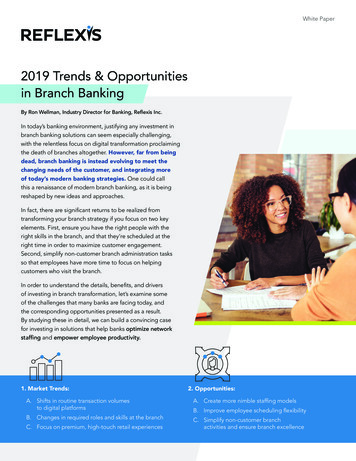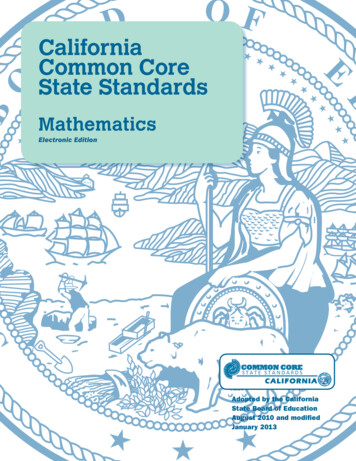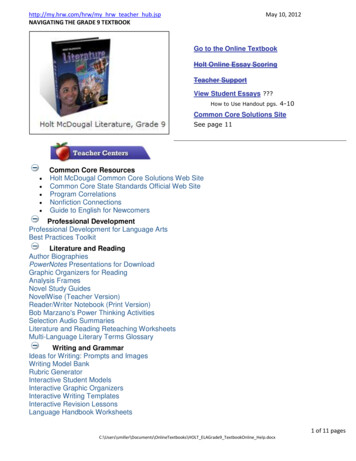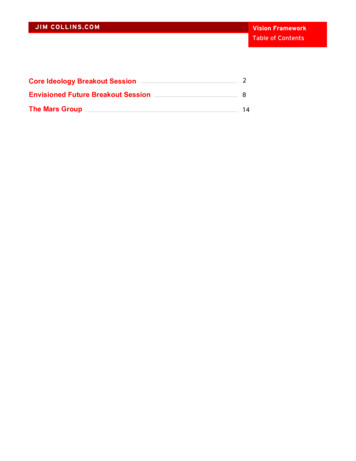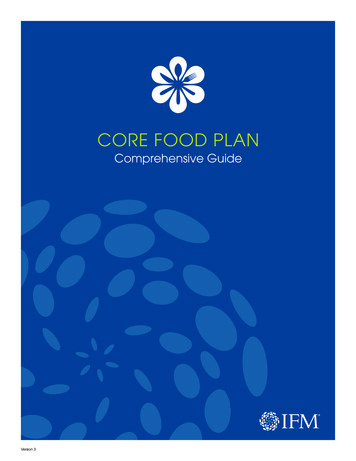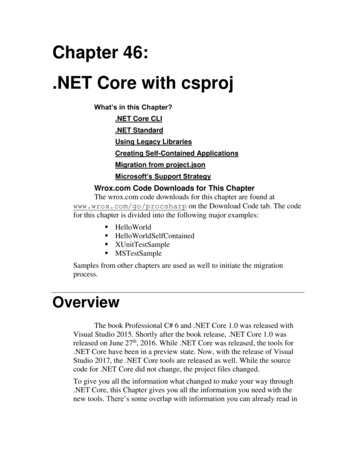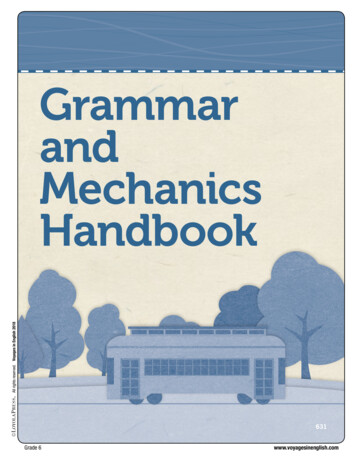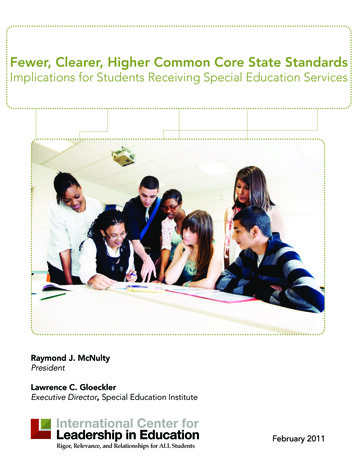
Transcription
Fewer, Clearer, Higher Common Core State StandardsImplications for Students Receiving Special Education ServicesRaymond J. McNultyPresidentLawrence C. GloecklerExecutive Director, Special Education InstituteRigor, Relevance, and Relationships for ALL StudentsFebruary 2011
1587 Route 146 Rexford, NY 12148 www.LeaderEd.comP: (518) 399-2776 F: (518) 399-7607
Fewer, Clearer, Higher Common Core State StandardsImplications for Students Receiving Special Education ServicesAmerican students must be fully prepared to compete successfully in a globaleconomy. The recently released Rising Above the Gathering Storm, Revisited:Rapidly Approaching Category 5 continues to warn that the United States is quicklylosing its competitive edge in the world.The top recommendation of the original National Academies report, Rising Abovethe Gathering Storm, was to “move the United States K-12 education system inscience and mathematics to a leading position by global standards.” Five yearslater, the recommendation is still the same.Common Core State Standards“ a good education isno longer just a pathwayto opportunity – it is aprerequisite.”- President Barack ObamaTo meet this challenge, a state-led effort by the National GovernorsAssociation Center for Best Practices (NGA Center) and the Council of ChiefState Schools Officers (CCSSO) has created Common Core State Standardsfor English Language Arts & Literacy in History/Social Studies, Science, andTechnical Subjects K-12 and for mathematical content and practice, withscience standards to follow. The purpose of these standards is to ensure aclear and consistent framework to prepare all students for college andthe workforce.In June 2010, the final version of the Common Core State Standardswas released. These standards address what students are expected toknow and be able to do. They are designed to be robust and relevantand to reflect the knowledge and skills that all young people will needfor success in college and careers.To that end, the standards: are aligned with college and work expectations are clear, understandable and consistent include rigorous content and application of knowledge through high-orderskills build upon strengths and lessons of current state standards are informed by other top performing countries, so that all students areprepared to succeed in our global economy and society are evidence-based.The manner of assessing these fewer, clearer, higher standards will be verydifferent from current methods of assessing state standards. Students will be3
required to use higher order thinking skills, apply what they have learned tounique situations, and bring together knowledge from a variety of content areasto solve problems. Students will be expected to engage in performance-basedevents, some of which will take place over long periods of time. In addition, theseassessment challenges will use a range of technologies with which students musthave become familiar during their class work.Teachers will be expected to monitor progress using a wide range of formativeassessments. Data from formative and end-of-course assessments will becollected, analyzed, and used to make instructional decisions to strengthenstudent performance.Common Core State Standards and SpecialEducationThe goal of the Common Core State Standards is to focus on the knowledge andskills needed by all students so they can be successful in college and careers.This goal applies for all students. Students who are receiving specialeducation services are no exception. They too are expected to bechallenged to excel within the general education curriculum based on“It’s not just that kids need to gothe Common Core State Standards.to school, they need to learn inschool.”The table that follows represents the percentages for selected categoriesof disability within the total population of identified students. The- Emiliana Vegaslargest category of students in special education is students withSenior Education Economistlearning disabilities, which means they have average or above averageWorld Bankintelligence according to the federal definition. This group accounts for39% of classified students. The second largest group is students whoare speech impaired. Also included are students who are hearing or visuallyimpaired, orthopedically impaired, other health impaired, emotionally disturbedor developmentally delayed. These categories encompass almost all students inspecial education. Most of these students by definition do not have a significantcognitive disability; many fit within the normal range on the intelligence scale.Percentage Distribution of 3- to 21-Year OldsServed Under IDEA by Primary Disability Type — 2007-08DisabilityPercentLearning disability39Speech or language impairment224
As districts and schoolsacross the country prepareto transition from theirexisting state standardsto the Common CoreState Standards they mustaddress the needs ofstudents receiving specialeducation services andother struggling studentsfrom the outset.DisabilityPercentOther health impairments10Emotional disturbance7Mental retardationDevelopmental delayAutismMultiple disabilitiesHearing impairmentsOrthopedic impairments“This [Senate]committee believesthat the critical issuenow is to place greateremphasis on improvingstudent performanceand ensuring thatchildren with disabilitiesreceive a quality publiceducation”- IDEA ReauthorizationCommittee854211For these students, the Common Core State Standards provide an opportunityto have access to the knowledge and skills necessary for a successful future. Asdistricts and schools across the country prepare to transition from their existingstate standards to the Common Core State Standards they must address the needsof students receiving special education services and other struggling studentsfrom the outset.Language in the Common Core State Standards outlines the areas that must beavailable to students receiving special education services in order for them todemonstrate their conceptual and procedural knowledge and skills in Englishlanguage arts (including reading, writing, listening, and speaking) as well as inmathematics: supports and related services designed to meet the unique needs of thesestudents and to enable their access to the general education curriculum(IDEA 34 CFR §300.34, 2004) an Individualized Education Plan (IEP) which includes annual goals alignedwith and chosen to facilitate their attainment of grade-level academicstandards teachers and specialized instructional support personnel who are preparedand qualified to deliver high-quality, evidence-based, individualizedinstruction and support services.5
To ensure meaningful and complete participation and success in the generaleducation curriculum for students receiving special education services thedevelopers of the Common Core State Standards suggest additional supportsand services be provided, as needed. They include: instructional strategies based on the principles of Universal Design forLearning (UDL). These strategies support student engagement by presentinginformation in multiple ways and allowing for students to access and expresswhat they know in a variety of ways“This review andauthorization of the IDEAis needed to move to thenext step of providingspecial education andrelated services tochildren with disabilitiesto improve and increaseeducational achievement”- IDEA ReauthorizationCommittee accommodations, including changes in materials and/or procedures. Animportant consideration is that these accommodations should not alter thestandards nor lower the expectations for students to successfully accomplishthe work. assistive technology devices and services to enable access to the standards.Access to the general education curriculum also includes access to the generaleducation assessments. Traditionally, students receiving special educationservices have been provided testing accommodations and, in some cases,modifications. In some instances, these accommodations/modifications haveresulted in expectations being lowered and students being assessed on materialthat is below grade level and/or not related to the knowledge and skillsnecessary for mastery of the content.When being assessed on the Common Core State Standards, all students will berequired to demonstrate understanding of the content and skills outlined in thekey ideas of the standards. They will demonstrate their understanding throughreading, writing, listening, and speaking and through mathematical practicesembedded in performance tasks during an end-of-course test and, also, throughtasks occurring throughout the course.Those students who have the most significant cognitive disabilities and whohave traditionally taken alternate assessments will require substantial supportsand accommodations. These additional supports will allow alternate assessmentstudents to have meaningful access to certain standards and assessments that areappropriate to the students’ communication and academic needs.Curriculum developers should be mindful that higher order content and skillsmay not have been part of the assessment requirements for students receivingspecial education services and accessing the general education curriculum. Asschools transition to the Common Core State Standards, the depth and breadth oftraditional assessment items and techniques should be taken into considerationand support provided so all students are prepared to be tested on higher orderthinking and performing.6
All students mustbe provided withopportunitiesto interact withthe technologiesavailable to fosterthe aptitudesand attitudesrequired forsuccess in collegeand careers.Providing theseopportunitiesis especiallyimportant forstudents receivingspecial educationservices.Many, if not all, of these performance tasks will be assessed using varioustechnologies. All students must be provided with opportunities to interactwith the technologies available to foster the aptitudes and attitudes requiredfor success in college and careers. Providing these opportunities is especiallyimportant for students receiving special education services. In many schoolsand classrooms, these students have not been provided the same level of accessto or instruction in technology use as general education students. In order tobe prepared for the new assessments and the new methods in which theseassessments will be administered, it will be important to bring students receivingspecial education services up to the level of proficiency that general educationstudents may already possess.Improving the Performance of StudentsReceiving Special Education ServicesNot every student with disabilities will meet academic standards, but that is not areason to stop providing support to help them achieve at high levels of learning.Many more students can reach standards than schools have imagined. Onecore issue that prevents high levels of learning is a culture of low expectations.Too many educators believe that students receiving special educations servicescannot perform at higher levels, and the programs offered reflect that attitude,from elementary school all the way through high school.Focusing on theneeds of studentsreceiving specialeducation servicesduring the initialstages of thistransition willbenefit all students.The examination and reflection on curriculum and instruction that transitioningto the Common Core State Standards requires will allow schools and districtsto improve their programs for all students. Focusing on the needs of studentsreceiving special education services during the initial stages of this transition willbenefit all students. The International Center has identified Five Key Elementsthat schools must address to support the achievement of students receivingspecial education services:1.ownership – understanding among staff that students receiving specialeducation services are the responsibility of all2. high expectations – understanding by administrators, faculty, and studentsthat all students will be challenged and expected to perform to the best oftheir ability3. intervention systems – policies, procedures, and protocols to ensure thatstruggling learners meet academic and/or behavioral expectations asmeasured by improved performance7
4. inclusion/collaborative teaching – teaching methodologies in which studentsreceiving special education services are included in the general educationclassrooms and have access to both content and special education expertise5. organization/professional development – successful programs for allstruggling learners depend on alignment of and access to standards-basedcurriculum, instruction, and assessment and data-driven professionaldevelopment to support teachers in achieving goalsOwnershipThe experienceof the SpecialEducation Institutehas shownthat buildingadministratorsmust take thelead for setting atone of collectiveownership. Theymust serve asprimary advocatesfor the studentswho need supportbeyond thestandard curriculumand instruction.Schools that are successful in raising the achievement levels of their specialeducation populations have established a culture in which the achievementof each and every student is considered a shared responsibility. These schoolsdiscourage a “yours and mine” attitude among administrators and faculty andfind ways to integrate general and special education programs so that all studentsare supported by all adults to perform to their highest potential.The International Center’s Special Education Institute has worked with manyschools and districts to increase the level of ownership of special educationstudents by all staff. One such district is Shenendehowa, outside of Albany, NewYork. A significant objective in the district’s strategic plan to improve the specialeducation program is to “share responsibility for student achievement amonggeneral education staff, special education staff, and other staff of the district.”The experience of the Special Education Institute has shown that buildingadministrators must take the lead for setting a tone of collective ownership. Theymust serve as primary advocates for the students who need support beyondthe standard curriculum and instruction, even if there is a dedicated specialeducation administrator in the building or district.High Expectations for AllHigh expectations are linked closely to ownership. A strong sense of communalresponsibility makes it possible to set lofty expectations for all studentsand establish a culture of support for each student to achieve. When theseexpectations are clearly stated and supported, students internalize them. Theyare more motivated to perform at higher levels. This is true of all students.8
Schools and districts with steadily improving performance levels for studentsreceiving special education services are intentional about holding highexpectations for achievement. For example, one goal of James Campbell HighSchool in Honolulu, Hawaii states clearly, “The performance gap betweengeneral education students and students receiving special education serviceswill be reduced to no more than 10% by 2014.” Wilson County Schools in NorthCarolina shares this goal.Similarly, in Florida, an Orange County Public Schools goal states that “80%percent of students receiving special education services will graduate with astandard diploma.” Another example of a clearly stated high expectation is fromShenendehowa: “By year 2014, 85% of students receiving special educationservices will reach at least a level 3 [proficiency] on State assessments.”These successful schools and districts recognize that “holding all students to thesame standards” is not the same as setting high expectations for each student.Many schools talk about holding all students to high standards, but they do notarticulate high expectations for achievement to their struggling students. Toooften, there is an attitude among administrators and faculty that students withdisabilities cannot achieve at higher levels. When this happens, standards arerelaxed, the curriculum is watered down, students give up or develop “learnedhelplessness,” and scores lag. This creates a vicious cycle of poor results forstudents who, more often than not, are capable of achieving at higher levels, butwho are not provided with the support to do so or the self-confidence that theycan.To be most effective, a culture of high expectations should exist throughout thedistrict. Administrators must ensure that every school building is on board.A districtwide culture enables students to continue to achieve no matter whichschool they attend or what grade level they are in. In some districts withoutuniform high expectations, middle school teachers can tell which elementaryschool their students have come from by the students’ expectations of themselves.Intervention systemsare most effectivewhen they are deeplyrooted in a school’sgeneral educationprogram ratherthan in the specialeducation program.Intervention SystemsSchools with well organized intervention systems tend to achieve highersuccess for all students. Interventions are planned using student-specificstrategies designed to change behaviors or improve skills. The purpose of anintervention system is not to place a student in a program, service, or setting,but to identify the student’s needs and implement a plan to meet them. In aneffective intervention program, lower-than-expected performance is a signal totry different approaches to instruction, not to refer a student for special educationservices.9
Intervention systems are most effective when they are deeply rooted in a school’sgeneral education program rather than in the special education program.Teachers and administrators continually collect and analyze data for eachstudent to provide individualized supports for every learner. In turn, an effectiveintervention system then works as a source of data to identify schoolwideinstructional issues. Ongoing support is provided to teachers in implementingdifferentiated instruction and other strategies to help them meet the varyinglearning needs of their students. When interventions are implemented effectively,many students who might have been referred to special education are supportedsuccessfully in general education.Most schools have intervention programs, but increasingly, they have strayedfrom their original purpose. Instead of helping students who are lagging behindachieve grade-level proficiency, these programs have turned into pre-referralsystems for special education. The programs are often evaluated on the numberof referrals to special education rather than on improvements in students’performance as a result of successful intervention. While some students do needto be referred for special education, the goal of intervention programs should benot to refer students unless absolutely necessary.Schools like James Campbell High School, with whom the Special EducationInstitute has worked have put intervention systems into place that identify andmonitor the needs of all struggling students. They use effective teaching methodsto improve student performance. The intervention teams that are formed use aproblem-solving approach to supporting students rather than viewing the team’swork as that of a “pre-referral” committee.Continuity ofintervention programsthroughout a districtis imperative. Thestudents who strugglein school are also theones who tend to bethe most transient.Successful programs like these are data driven for both students and teachers.Intervention teams analyze data from many sources, including attendancerate and number of low or failing grades on a student’s report card. Focusedprofessional development is also data driven and is provided in areas identifiedby the teams themselves. Success is measured by improving student performance,not the number of referrals to special education as had been the measure in thepast.As with high expectations, continuity of intervention programs throughout adistrict is imperative. The students who struggle in school are also the ones whotend to be the most transient. When they move from one school to another ina district where there is no consistency between buildings, school becomes evenmore difficult for them. If students who are receiving interventions that areworking transfer to another building where school staff are not familiar with theinterventions, it is challenging for those students to adjust and succeed.10
Inclusion/Collaborative TeachingIn most schools that show high performance for students with disabilities,special education serves more as a support system for general education than asa separate program. School climate means everything, particularly for studentswho are struggling academically, highly mobile, lacking self-confidence, orstruggling to belong. These students must have access to the general educationcurriculum. Simply placing them in general education classrooms is notthe answer, however. Schools must create systems to help students get theinstructional support they need to succeed.In many schools,students withdisabilities are inspecial classes wherethe special educationteachers are teachingmath, Englishlanguage arts, socialstudies, and scienceeven though they havenot been trained inany of those subjects.It is not surprising thatthe performance ofthese students hasbeen poor.For years, schools all over the country have referred students to special educationbecause they were not reading well. In doing so, they have placed students with ateacher who is often not trained to teach reading. In many schools, students withdisabilities are in special classes where the special education teachers are teachingmath, English language arts, social studies, and science even though they havenot been trained in any of those subjects. It is not surprising that the performanceof these students has been poor.Transitioning to a collaborative model is not easy, but it can and must be done.Many schools have not defined what their “inclusion” program is. As a result,they are unable to articulate what is expected of teachers or to develop andimplement the systems to support teachers or students. When they launch acoordinated process to create a culture in which high expectations and inclusionare the norm and the appropriate support systems are put in place, they seeincreases in student performance.One of the most effective strategies for inclusion is collaborative teaching,frequently designed as a co-teaching model. When correctly implemented andsupported, the collaborative teaching model increases performance dramaticallyfor students with disabilities over time. One of the most effective co-teachingarrangements pairs a special education teacher with a content area teacher in ageneral education classroom. In this model, the general and special educatorsshare instructional responsibility, resources, and accountability for all thestudents in the classroom. Together the teachers plan, present, and evaluateinstruction and student progress. They also share equally in classroom andbehavior management. Almost always, the performance of both the generaleducation and special education students improves.Collaborative teaching is most successful when schools: define clearly which students can benefit from exposure to the generalcurriculum maintain a ratio of one-third or fewer special education students to generaleducation students in the classroom11
implement ongoing, high-quality professional development around the coteaching approach to keep it from evolving into a teach/assist model schedule regular common instructional planning time for teaching teams andprotect that scheduled time build in time before the school year begins so co-teachers can discussphilosophies, logistics, classroom management, and other non-instructionalissuesAt James Campbell High School, the full-inclusion program has 16 co-teachersteaching special education students in general education classes for the entireschool day. Zaricke Jackson, a special education teacher in a co-taught classroomsums up the successful collaboration, “We feed off each other’s strengths.”Over the three years since James Campbell High School moved to inclusion andcollaborative teaching, data show double digit gains in the percent of studentsreceiving special education services testing at proficient levels in math andreading. Campbell High School also has data to support the phenomenon thatmany other inclusion programs experience: the performance of general educationstudents in co-taught classrooms also improves.James Campbell High School90%80%70%60%50%Reading - SPEDMath - SPEDMath - GE40%Reading - nother example of successful co-teaching is in Brockton (Mass.) High School.Co-teaching has been an important aspect of its special education program, and12
performance in English Language Arts for both general and special educationstudents continues to improve. Special education students’ performance (thesecond dark line) has improved so much, they are now surpassing performanceof general education students in other Massachusetts urban districts.Proficiency Index - ELA - Mass. UrbansGradeBandSub rocktonGrd 10Agg76.478.179.284.083.28811.6LynnGrd 10Agg70.570.773.077.278.182.712.2WorcesterGrd 10Agg67.968.671.875.379.382.614.7BostonGrd 10Agg64.467.769.776.578.182.317.9LowellGrd 10Agg69.874.273.676.478.981.411.6Fall RiverGrd 10Agg69.871.772.172.681.479.29.4NewBedfordGrd 10Agg66.169.170.574.374.578.212.1SpringfieldGrd 10Agg62.165.666.767.369.776.714.6BrocktonGrd 10Agg51.350.254.061.863.370.419.2LawrenceGrd on/Professional DevelopmentSchools like Brockton, James Campbell, Wilson County, and Shenendehowaare examples of how important organizational support is to successful specialeducation programs. Administration, faculty, and parents are integral tothe successful and sustainable implementation of all of the key strategies toimprove the performance of students receiving special education services.Strong organization, especially throughout a district, minimizes inconsistenciesin attitudes that hinder student achievement and allows best practices to beimplemented to the advantage of staff and students.For example, districts can implement regular instructional monitoring usingassessments and give teachers the capability to review data online. This enablesteachers to adjust instruction as they go, so that they can have the greatest impactin the classroom for every student, from the highest performing to the ones whoneed intervention and support.Strong organizational structures can also have a positive impact on studentachievement across grade levels and schools. Individual schools may succeed inaligning their own curriculum, but curriculum alignment across schools lendsitself to smoother transitions for struggling learners.13
Successful schoolsfocus first onlearners who havespecial needs whensetting schedules.This allows themto protect theintegrity of thecollaborativeteaching modeland ensurethat ongoingprofessionaldevelopment andother essentialsupports are notoverlooked.Another particularly effective practice observed by the International Centerrelates to scheduling. Successful schools focus first on learners who have specialneeds when setting schedules. This allows them to protect the integrity of thecollaborative teaching model and ensure that ongoing professional developmentand other essential supports are not overlooked. Common planning time maybe difficult to arrange, for example, but it is absolutely essential. Administratorsreport that it is far easier to address the scheduling needs of the general educationprogram after they have attended to those of special needs learners.Strong organization is also essential for professional development, which isa fundamental element in launching and sustaining any initiative to supportlearning for all students. Successful schools create professional learningcommunities in which teachers have opportunities to receive high-qualitytraining and ongoing support that is aligned with strategic goals.In effective schools, professional development focuses on what the data revealis important, as well as on the needs of the students and faculty, and it stayspersistent over time. Staff development is done not only in workshops, but also atthe building level and with classroom follow-up. This support in the classroom,provided through a variety of strategies, helps teachers internalize their newlearning.In Garden City, Michigan, an overarching goal of the special education programis to reduce the classification rate of students. Administrators and teachers havebeen persistent in pursuing this goal. Professional development activities havefocused on the Five Key Elements with the express goal of reducing classificationrates. The success of choosing a goal and being relentless in its pursuit is shownin the graph that follows. Special education classification rates have decreased inGarden City for three straight years.Analyzing the Five Key ElementsHistorically, what many educators have believed students with disabilitiesare capable of does not align with what these students show they can doif the right systems are put into place. When coordinated in a school andacross a district, the Five Key Elements – a sense of ownership, a culture ofhigh expectations, intervention systems, inclusion and collaboration, andprofessional development – converge to create an environment in whichstudent learning is the priority. The result is that achievement improvesfor the entire student population.14
SE Identification Rates Garden City District of Residence Data20.00%18.00%16.00%Percent of Enrollment14.00%12.00%Garden 00720082009The Special Education Institute at the Internat
The recently released Rising Above the Gathering Storm, Revisited: Rapidly Approaching Category 5 continues to warn that the United States is quickly losing its competitive edge in the world. The top recommendation of the original National Academies report, Rising Above the Gathering Storm
